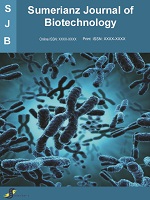Sumerianz Journal of Biotechnology

Online ISSN: 2617-3050
Print ISSN: 2617-3123
Quarterly Published (4 Issues Per Year)
Journal Website: https://www.sumerianz.com/?ic=journal-home&journal=32Archive
Volume 3 Issue 12 (2020)
Evaluation of Antihyperlipidaemic and Antioxidant Activity of Astercantha longifolia (Linn.) Nees and Pergularia daemia (Forsskal) Chiov
Authors : T. P. Kumari Pushpa Rani ; A. Doss ; S. P. Anand
DOI : doi.org/10.47752/sjb.312.134.138
Abstract:Objective: To evaluate the antioxidant and antihyperlipidaemic effect of methanol extracts of Asteracantha longifolia and Pergularia daemia leaf in alloxan induced diabetic rats. Methods: Swiss albino rats were made diabetic by a single dose of alloxan monohydrate (150 mg/kg i.p.). Blood glucose levels and body weights of rats were measured using on weekly intervals i.e day 0,7,14 and 21 after daily administration of both extracts at dose 200 mg/kg bw. Other biochemical parameters such as serum cholesterol, triglycerides, low density lipoprotein-cholesterol, very low density lipoprotein-cholesterol, high density lipoprotein-cholesterol, phospholipids and serum protein, albumin, globulin levels were also measured at the end of study. The antioxidant enzymes (CAT, SOD & GSH) were also measured in the diabetic rats. Results: In the acute toxicity study, methanol extract of both plants were non-toxic at 2000 mg/kg in rats. The increased body weight, decreased blood glucose and other biochemical parameters level were observed in diabetic rats treated with methanol extracts of both plants compared to diabetic control rats. The antioxidant activity of both plant extracts were also exhibited significant activity. In diabetic rats, methanol extract of both plants administration, altered lipid profiles were reversed to near normal than diabetic control rats. Conclusions: Methanol extract of both plants (Asteracantha longifolia and Pergularia daemia) leaf possesses significant antioxidant and antihyperlipidaemic activity in diabetic rats.
Chemical Composition and Bacteriological Quality of Cow Raw Milk Collected From Daim Algarrai Area
Authors : Omaima A. Madani ; Telal M. Najeeb ; Abdelhalim A. Hamza
DOI : doi.org/10.47752/sjb.312.126.133
Abstract:This study was conducted to assess the factors influencing milk quality from dairy farmers in the Deam ALgarri aera in Sudan. A total of twenty row cow’s milk samples were collected from dairy farmers. The physicochemical parameters, bacteriological quality, milk adulteration and drug residues were assessed. The presence and enumeration of microorganisms was done based on Total Plate Count (TPC), Total Coliform Count (TCC), Total Staphylococcal count (TSC), and detection of pathogenic E. coli (O157: H7). The mean value of aerobic bacteria in the milk samples showed the higher TPC, TCC followed by TSC which were 111608 CFU/ml (log 4.95), 8145CFU/ml (log 3.42) and 6793.25 CFU/ml (log 3.29) respectively. The result of the detection of Escherichia coli O157:H7 which is a major foodborne pathogen causing severe disease in humans worldwide, all milk samples appear free from this pathogenic bacterium. The results of the physical properties of cow milk showed normal flavor, taste and colors, and higher pH (7.12), and total water (156%), the exception was the freezing point (- 0.444) and specific gravity while showed lower value (1.029) compared to SSMO limits but within FAO limits. The chemical properties of cow milk showed high amount of protein content (3.49%), lower solid not fat (SNF) which was (7.97%), Lactose (3.73%) and total solid (TS) (0.58%) when compared to both Sudanese Standard and Metrology Organization (SSMO) and Food and Agriculture Organization (FAO) standards. The result of presence or absence of antibiotic residue to the all milk samples was indicated absence antibiotic residues with (6 mm) and (7 mm) zone inhibitor against Bacillus subtilis. Isolation and identification of some pathogenic bacteria was performed according to standard methods, the results demonstrated the presence of food-borne microorganisms E. coli, klebsiela, sp, Pseudomonas sp, and Shiglla sp. with percentages of 31.1%, 29.7%, 38.4%, and 1% respectively, the presence of these bacteriological quality in the raw milk samples indicted an urgent need to implement good hygiene practices from farm to the consumer.
Comparison between Water Hyacinth and Waste Cooking Oils as Source of Biofuel Production
Authors : Esraa M. Abd El-halim ; Mennatullah M. Moustafa ; Alaa A. Mahmoud ; Hager S. Ahmed ; Emad A. Shalaby
DOI : doi.org/10.47752/sjb.312.118.125
Abstract:The problem of fossil fuel increases by time around the world, Biodiesel is an environmentally friend renewable diesel fuel alternative. The present work aims to determine the possibility for biofuel production from non-edible plant (Water hyacinth) and waste cooking oils in addition to potential uses as source for glycerol, pigments and antioxidant compound sources. this study aimed to investigate the feasibility of biodiesel production from water hyacinth using two solvent systems (chloroform: methanol, 2:1v/v and Hexane), Moreover, WCO applying one steps alkaline transesterification process using methanol, NaOH (0.25) and KOH (0.25, 0.5 and 1g) as a catalyst and hot distilled water for purification. both produced biodiesel (from Eichhornia and WCO) was characterized using FTIR and some chemical constant such as IV, SV and AV. The highest biodiesel produced from Eichhornia recorded with chloroform: methanol system when compared with Hexane. However, the highest biodiesel produced from WCO was recorded when using KOH (0.25g). Also, the obtained results reported the possibility for use glycerol produced from the both biofuel sources in body butter (makhmaria) production, Authors concluded that, the produced biodiesel from both sources was within the recommended standards of biodiesel fuel. Also, water hyacinth became useful in antioxidant compounds production, the contained pigments may be used as natural coloring substances in different fields.



